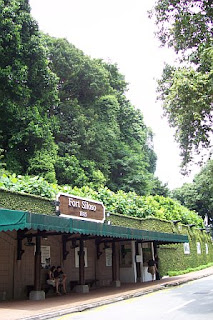
My interest in learning more about World War II and forts in this part of the world had prompted me to visit Fort Siloso a few weeks ago. My visit makes me realise that Fort Siloso is the place for visitors to Sentosa to visit if they wish to appreciate how the island of Sentosa was once a British military fortress before it has evolved into today's island resort. In those days, what we now know as Sentosa was known as Pulau Blakang Mati — the "Island behind the Dead".
There are many ways to find one's way to Fort Siloso. That day, I took the Sentosa's Blue line bus from the bus terminal at Beach Station and alighted nearby the Underwater World. The entrance to Fort Siloso is just within walking distance from the Underwater World.
An admission ticket into Fort Siloso grants one the privilege to take a ride on one of the Fort Siloso bus. A staff from the Fort Siloso would give visitors a brief orientation to Fort Siloso, and the first stop for the visitors of Fort Siloso is at the casemates at Fort Siloso Square.
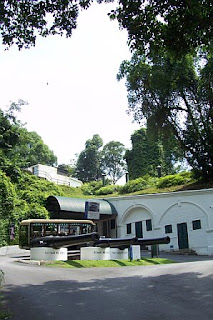
Fort Siloso bus and the casemates.
There are many things to see during the tour of Fort Siloso. I chose to explore the grounds of the Fort Siloso on my own. For the convenience of the visitors, the premises of Fort Siloso have been divided into three different zones.
The Red Zone brings visitors to better understand World War II history in this part of the world. At the Yellow Zone, visitors get to experience how life at the fort would be like for a soldier. The Blue Zone takes one to visit the longest Tunnel complex under Mt Siloso, and the tunnel complex leads to the Gun Direction Tower.
There is an exciting-looking replica of a 6-inch cannon at the Tunnel & Gun Complex. This webpage gives an informative account about the replica of the 6-Inch BL Gun Battery at Fort Siloso and I dare say it is worth checking out: http://www.fortsiloso.com/guns/6in/no1/no1.htm.

Underground, there are more for the visitors to explore. The question some may have in mind would be: Why is Fort Siloso built underground? This site provides an informative account: http://www.fortsiloso.com/underground/underground.htm

Kerosene lamps in such tunnels would usually be kept behind glass panels for safety reasons.


A replica of a hoist. Such hoists were used to raise shells and cartridges from the magazine level to the gun emplacement found above.
Visitors to Fort Siloso should also check out the Tunnel A complex. However, according to this site, technically speaking, there is no real tunnel at Fort Siloso. This sounds fairly confusing to a lay-person like myself. It just seems that I may soon need a military historian to enlighten me?
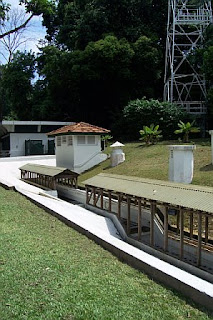
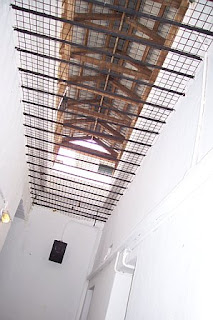
Soon after exiting from the Tunnel A complex, one would find oneself at Siloso Point. This is a beautiful part of the island for a visitor to be at. Here one can have a nice view of the Southern islands.


Siloso Point
Just some steps away, one can also get a good view of Labrador Park and the once Fort Pasir Panjang. Together with Fort Pasir Panjang , Fort Siloso had served as a coastal artillery defence that protected the sea entrance to Keppel Harbour.

Overlooking Labrador Park. Right across is the main island of Singapore.
After some walking, I found myself back at Fort Siloso Square. At the Red Zone, there are exhibits on the Fall of Singapore, the Special Operations Force 136, and the Japanese Occupation. For a visitor who does not have much background to this part of history, the exhibits give a quick introduction.
Visitors to Fort Siloso will be treated with guns and more guns. Quite a number of these guns are guns which were not originally placed at Fort Siloso. For those of you who are keen to know more about these guns, I would recommend you to visit this site: http://www.fortsiloso.com/museum/museum.htm
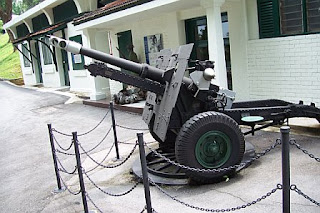
British 25 Pounder Gun-Howitzer
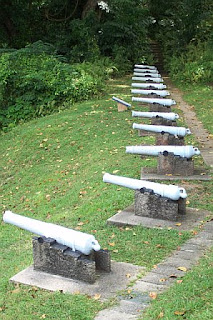
Istana Guns
Some of you may be curious to find out how the heavy gun barrels were moved to their emplacements in those days when manpower and animal-power were all that were available. The method that was used was called parbuckling. I like this site that gives a good overview of parbuckling: http://www.fortsiloso.com/history/1874/parbuckle.htm

There is a Battery Command Post that was built at the top of Mt Siloso. With the help of the figurines on display, it was quite interesting to have a sense of how the soldiers would be at work.

What you see in this post is just a fraction of what visitors to Fort Siloso can get to experience. There are exhibits like the one you would see in the photo below that let visitors catch glimpses of the life of the solders who had served at Fort Siloso. I also recommend that visitors check out the Tunnel C Complex to see an elaborate display of how ammunition for Fort Silos's cannons was stored and moved.

Re-enactment of the living quarters of the soldiers.

Tunnel C complex.
Last but not the least, before visitors make their way for home, it will be recommended that visitors check out the Surrender Chambers. The Japanese did not surrender at Fort Siloso, but there are two exhibition halls with life-size wax-models that re-enact the British surrender in 1942 and the Japanese surrender to the Allies in 1945. I figured that since I cannot be present to witness these two historical events, the next best thing would be have a glimpse of the re-enactment of these two events.

Surrender Chambers.
This exhibit reminds me of my post on a visit to the Memories at Old Factory, where the actual British surrender had taken place.
My last stop was the QuarterMaster Store. After some browsing, I took the Fort Siloso tram out of the fort. On my way out of Fort Siloso, it awed me to think of how the island of Pulau Blakang Mati has transformed from a military fortress of yesterday to the island resort of today. I suppose the preservation of the past can help future generations like myself appreciate the present better.
***
Visitors' Information:
Admission to Fort Siloso is as follow:
Adult S$8
Child S$5 (3 - 12 years old)
Sentosa Island admission and transport charges apply
Opening hours:
10 a.m. - 6 p.m. daily (last entry 5.30 p.m.)
Guided tour are available every Sat & Sun, 11 a.m. and 4 p.m. Limited to 20 guests per session. First-come-first-served basis. Register for the guided tour at no additional charge at the Fort Siloso Tram Station.
***
References:
http://www.fortsiloso.com/
http://www.sentosa.com.sg/explore_sentosa/attractions/fort_siloso.html
Also read:
The Other Siloso
Fort Siloso
Afternoon at Labrador Park
The timings of your Fort Siloso tours are wrong. They have now changed the timing.
ReplyDelete